This tutorial is intended for those new to building apps in the cloud, such as engineers and web developers, who want to learn key app development concepts as they apply to Cloud de Confiance by S3NS.
Deploying your app to Cloud Run
Cloud de Confiance offers several options for running your code. For this example, you use Cloud Run to deploy a scalable app to Cloud de Confiance. Cloud Run doesn't require you to manage servers and automatically scales to support traffic spikes.
Follow the instructions at Deploying your app to Cloud Run.
When the deployment succeeds, it outputs an endpoint to the app running in Cloud Run, in the following format:
https://bookshelf-abcdefghij-uc.a.run.app
Your app is now viewable at this link, hereafter called YOUR_CLOUD_RUN_URL. In your web browser, enter the URL to view the app.

Persist your data with Firestore
You cannot store information on your Cloud Run instances, because it is lost if the instance is restarted, and doesn't exist when new instances are created. Instead, you use a database that all your instances read from and write to.
Cloud de Confiance offers several options for storing your data. In this example, you use Firestore to store the data for each book. Firestore is a fully managed, serverless, NoSQL document database that lets you store and query data. Firestore auto scales to meet your app needs, and scales to zero when you're not using it. Add your first book now.
- In your web browser, go to your YOUR_CLOUD_RUN_URL.
-
To create a book for your deployed app, click Add book.
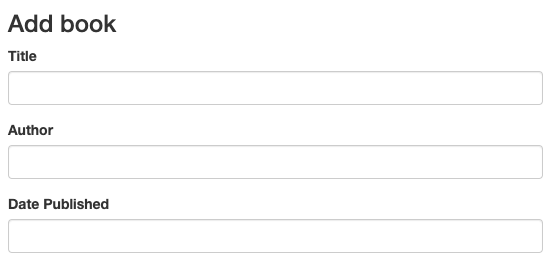
- In the Title field, enter
Moby Dick. - In the Author field, enter
Herman Melville. -
Click Save. There is now an entry to your Bookshelf app.
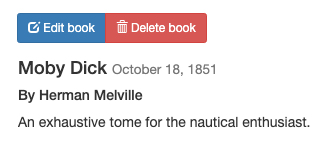
-
In the Cloud de Confiance console, to refresh the Firestore page, click
Refresh refresh.
The data appears in Firestore. The Bookshelf app stores each book
as a
Firestore document
with a unique ID, and all these documents are stored in a
Firestore collection.
For the purposes of this tutorial, the collection is called books.
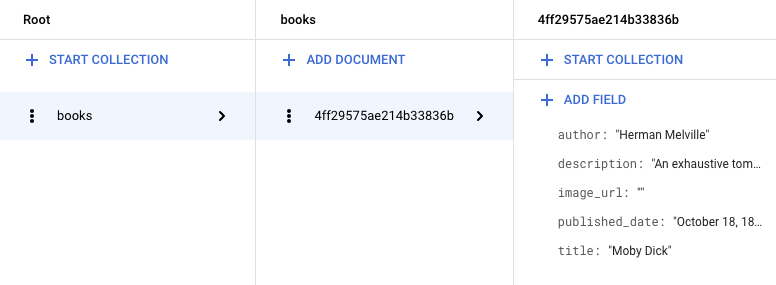
Firestore stores the books by using the Firestore Client Library. Here is an example of fetching a Firestore document:
For more information on using Firestore, see Adding data to Firestore.
Store file uploads in Cloud Storage
Now that you've added a book, it's time to add the book cover image. You cannot store files on your instances. A database isn't the right choice for image files. Instead, you use Cloud Storage.
Cloud Storage is the primary blob store for Cloud de Confiance. You can use Cloud Storage to host app assets that you want to share across Cloud de Confiance. To use Cloud Storage, you need to create a Cloud Storage bucket, a basic container to hold your data.
- In the Cloud de Confiance console, go to the Cloud Storage Browser page.
- Click Create bucket.
- In the Create bucket dialog, enter a name for your bucket by appending your
Cloud de Confiance project ID to the string
_bucketso the name looks likeYOUR_PROJECT_ID_bucket. This name is subject to the bucket name requirements. All other fields can remain at their default values. - Click Create.
- After your bucket is created, objects must be made publicly accessible to be viewed by users. To make your objects publicly accessible see Making Data Public.
-
Click Edit book, and select an
image to upload as your book's cover. For example, you can use this public
domain image:
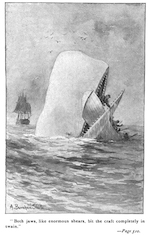
-
Click Save. You're redirected to the
homepage, where there is an entry to your Bookshelf app.
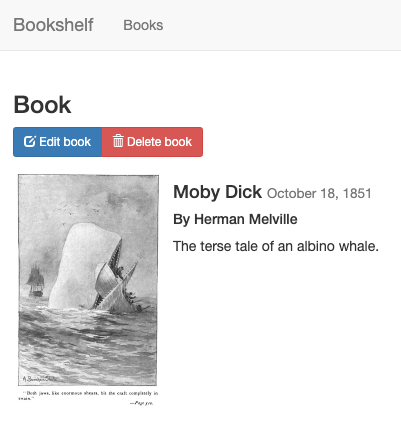
The bookshelf app sends uploaded files to Cloud Storage by using the Cloud Storage Client Library.
For more information on using Cloud Storage, see the Cloud Storage introduction.
Monitor your app using Google Cloud Observability
You've deployed your app and created and modified books. To monitor these events for your users, use Application Performance Management.
Monitor logs with Cloud Logging
-
In the Cloud de Confiance, go to the Logs Explorer
Go to Logs ExplorerYou can monitor your app in real time. If you have any issues with your app, this is one of the first places to look.
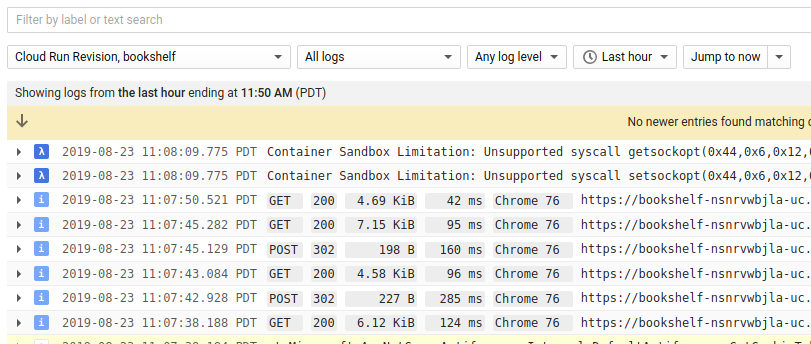
- In the Resource drop-down list, select Cloud Run Revision, bookshelf.
Monitor errors with Error Reporting
-
In the Cloud de Confiance console, go to the Error Reporting page.
Go to Error Reporting page
Error Reporting highlights errors and exceptions in your app and lets you set up alerting around them. -
In your browser, go to the
/errorsURL in your app.
YOUR_CLOUD_RUN_URL/errors
This generates a new test exception and sends it to Google Cloud Observability.
-
In the Cloud de Confiance console, return to the Error Reporting page, and in a few moments the new error is visible. Click Auto Reload so you don't need to manually refresh the page.

